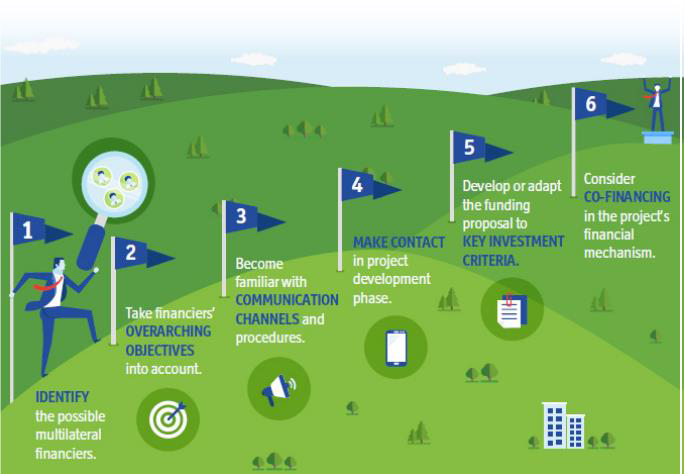How can developing countries tap into climate mitigation funds from MDBs and the GCF?

The clock is ticking and the world needs a rapid curb of greenhouse gas (GHG) emissions to avoid surpassing the 2°C threshold. Due to the ratification of the Paris Agreement, countries face the demanding task of implementing policies to decarbonise their economies. The challenge is daunting, especially for developing countries, because governments need to shift their development pathways to net zero emissions before the end of the century. At the same time, they need to ensure that this shift does not hamper economic prosperity. The right policies and regulations need to be in place to mark the path to achieve these two goals. With clear policies and regulations, stakeholders will have a common ground and clear direction to develop and implement on-the-ground projects that contribute to the achievement of net zero carbon economies and economic prosperity. However, an enabling environment is not enough.
A solid and credible pipeline of mitigation projects is fundamental to staying on that path. Developing country stakeholders can draw lessons from their 10 years’ experience with Nationally Appropriate Mitigation Actions (NAMAs). Back in 2007, developing countries committed to carrying out voluntary climate change mitigation actions with the financial and technical support of developed countries. However, according to Ecofys’ research, less than 10% of the NAMAs have secured implementation finance. There is a clear need to reframe the existing NAMAs so that they can enable investments in low carbon growth. One way to do this is by making NAMAs attractive to financiers.
Financiers seek investments in projects that are scalable and viable over a long period of time. Our research on climate finance from multilateral development banks (MDBs) and the Green Climate Fund (GCF) shows that there are five common investment criteria for mitigation projects among these funders:
- Country ownership: Project’s goals should be consistent with national priorities and development plans.
- Consistency with nationally determined contributions (NDCs): Projects should aim to achieve the NDC targets.
- Policy and regulatory framework: Governments should make sure that there is an enabling environment for climate investments; effective policies and regulations need to be in place.
- Scalability: Projects should be designed in a manner that allows wide replicability and enables investments that can be scaled up over a longer timeframe.
- Profitability: Projects should have an attractive rate of return; the gains of the investment must be larger than its costs.
Ecofys proposes six steps to increase the success in developing a pipeline attractive to MDBs and the GCF:
- Identify the multilateral financiers that serve the target country: Financiers have specific regions where they focus their operations. The World Bank Group (WBG) and the GCF are global players, while other MDBs are focusing exclusively on specific regions.
- Take financiers’ overarching objectives into account: For example, the European Bank for Reconstruction and Development (EBRD) seeks projects that have the private sector at the core of the project design. Likewise, mitigation projects seeking finance from the African Development Bank (AfDB), Inter-American Development Bank (IDB), or the WBG should highlight the ways in which they contribute to the achievement of NDCs and Sustainable Development Goals (SDGs).
- Become familiar with communication channels and procedures used by potential financiers: The primary counterparts of most MDBs are typically the national finance or economic planning ministries. The GCF relies on National Designated Authorities, which are responsible for communicating national priorities to the fund.
- Contact financiers during the project development phase: Through an early exchange, project developers can ensure that preferences and suggestions from the potential financier are considered in the final proposal. Proponents should already have a concrete project idea, ideally along with a business plan. Multilateral financiers usually don’t expect project proponents to approach them with a finalised funding proposal; instead, they offer support in the project development phase.
- Develop or adapt the funding proposal to key investment criteria: Project proponents should ensure that the funding proposal meets the respective financier’s investment criteria, uses a similar language, and takes the financier’s comments from the initial exchange into account.
- Consider co-financing in the project’s financial mechanism: co-financing increases scalability and decreases risks. It typically comes from other international public sources, domestic public money, or the private sector. Usually, multiple co-financing sources are preferred.
While it is true that current available international finance is not enough, countries should prioritise utilisation of limited resources efficiently. The argument of limited resources will continue to linger in the climate international debate. While it is a valid debate, the world cannot afford to wait until the finance is enough to reduce emissions. Developing countries must veer their efforts toward developing national decarbonisation strategies along with a large pipeline of bankable projects that are attractive to investors.
The increased 2020 climate finance targets of MDBs and increasing pledges to the GCF mean that rising amounts of mitigation finance will likely be made available in the coming years. This represents an opportunity for developing countries and project developers to tap into these resources. It is time for creating bankable project pipelines in each country to ensure that the decarbonisation of the global economy takes place before it is too late.
By Angélica Afanador, Ecofys
